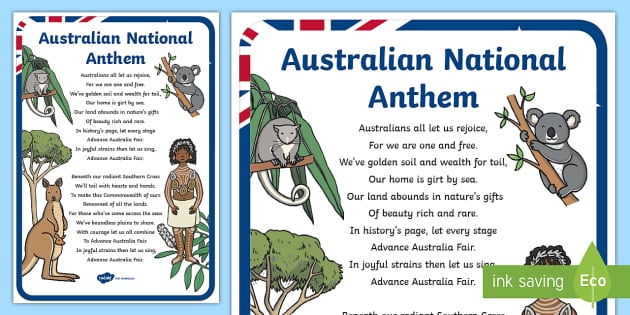Embracing Heritage: A Parent’s Guide to Australian Anthem Songs
Greetings, Aussie mums and dads! ? Are you keen on sharing a slice of our proud heritage with your little ones? You’ve come to the right place! This guide is a treasure trove of insights and tips on how to introduce the heartwarming strains of Australian anthem songs to your children. Let’s embark on a melodious journey to nurture their sense of national pride and understanding of Australia’s rich history through music. Ready to sing along?
Why Teach Your Kids Australian Anthem Songs?
Before we dive into the hows, let’s chat about the whys. Teaching your kiddos the Australian National Anthem, “Advance Australia Fair”, along with other patriotic songs isn’t just about memorising lyrics; it’s about instilling values, fostering a sense of unity, and connecting them to the storied past and vibrant future of the land down under. Shall we?
A Brief History of the Australian National Anthem
Did you know that “Advance Australia Fair” has been the official anthem only since 1984? Composed by Peter Dodds McCormick in 1878, it’s a song that has woven its way through generations, reflecting the spirit and determination of Australia. Understanding its history is a great starting point for teaching your child its significance. We’ll dive into that fascinating tale, and also explore other anthems that have echoed through Australia’s history.
Lyrics and Their Meanings
Every line in “Advance Australia Fair” is packed with meaning that represents the Australian ethos. We’ll go through the anthem line by line, explaining the significance, the imagery, and the unity it’s meant to evoke. But let’s not stop there! There are plenty of other songs that are equally evocative of Australia’s values and beauty. Prepare to give your child a deeper understanding – and perhaps learn something new yourself!
Fun Ways to Learn Australian Anthem Songs
Now, we know that learning anthems could sound a tad formal, but fear not! We’ve got a bunch of fun, interactive methods up our sleeves. From karaoke evenings to creative art projects, we will look at a myriad of ways to make this learning experience as enjoyable as it is educational.
Incorporating Anthem Songs Into Daily Life
Ever considered making the anthem part of your family’s daily routine? Whether it’s a morning sing-along or an anthem-a-week challenge, we’ll explore how you can seamlessly integrate these songs into your everyday life, ensuring that their messages of unity and pride resonate regularly.
Tying It All Together: Patriotism and Multiculturalism
Australia is a multicultural tapestry, and our anthems can be a reflection of this diversity. We’ll discuss how to respect and include the varied backgrounds and cultures that make up modern Australia while appreciating the anthems that have historically brought us together.
Crikey, we’re just getting started! Stay tuned as we continue to expand on these themes and guide you step by step through the joyful process of teaching your children about Australian Anthem Songs. It’s not just a lesson in music; it’s a journey through culture, history, and identity that will leave your family feeling more connected than ever to this great nation. Let’s continue singing our stories, one anthem at a time!

5 Essential Tips for Parents: Introducing Australian Anthems to Your Kids
Hey there, bright-eyed Aussie parents! ? Are you excited to pass on the baton of Australian pride through our beloved anthems? Well, strap in because we’re about to make that ride a whole lot smoother with some trusty tips. Teaching your bubs about Australian anthem songs is more than just hitting play; it’s about crafting experiences that stick and stories they’ll retell. Here are five nifty nuggets of wisdom to help your family’s anthem adventure take flight!
1. Create a Festive Learning Environment
First things first, set the stage for fun! Transform a part of your home into a mini-concert hall decked out with all things Aussie – think flags, maps, and iconic Aussie images. Make sure it’s a place where your little Vegemites feel comfy and excited to belt out tunes that have rallied Australians for years.
2. Use Technology to Your Advantage
No need to stick to the sheet music; we’ve got tech on our side! Use apps, videos, and online games to help your kids learn the lyrics and meaning behind “Advance Australia Fair” and other patriotic songs. Educational apps can offer quizzes, fun facts, and interactive sing-alongs, making each session a digital adventure.
3. Storytelling is Key
Combine the anthem’s lyrics with compelling stories of Australian history and folklore. Explain the symbolism behind phrases like “girt by sea” and “fair” in “Advance Australia Fair”. Make it a tale of discovery, where every line unravels a new chapter of Australia’s journey.
4. Practice Makes Perfect
Consistency is your best mate here. Encourage daily practice, but keep it light and enjoyable. Perhaps play the anthem every morning during breakfast or have weekly family performances. No pressure – just loads of clapping and encouragement to go ’round!
5. Embrace Australia’s Diversity
Remember, Australia’s heart beats in many different cultures. Along with traditional anthems, introduce songs from the varied communities that make up our vibrant nation. It’s a great way to celebrate our diversity and teach inclusivity alongside national pride.
There you have it! With these tips, you’ll empower your kiddos to sing their Aussie hearts out with understanding and passion. After all, anthem songs are not just tunes; they are the echoes of our shared stories and dreams. Go on, mate, help your kids learn those soaring melodies, and together, let’s keep the Aussie spirit alive – one anthem at a time!
For more great fun click here. For more information see here
Disclaimer
The articles available via our website provide general information only and we strongly urge readers to exercise caution and conduct their own thorough research and fact-checking. The information presented should not be taken as absolute truth, and, to the maximum extent permitted by law, we will not be held liable for any inaccuracies or errors in the content. It is essential for individuals to independently verify and validate the information before making any decisions or taking any actions based on the articles.




